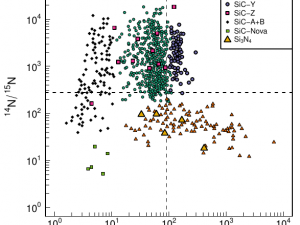Microscopic grains of dust from supernovae can become embedded into meteorites that eventually make their way to earth. Careful isolation and isotopic analysis of these grains then provides us with pristine isotopic abundance ratios from individual exploding stars. Of particular interest are isotopic abundance ratios, which can show strong deviations of orders of magnitude from the nearly constant ratios found elsewhere in the solar system. Not only can these ratios provide us with important information regarding the grains’ origin, but can help us constrain stellar models. Unlike observational astronomy, which provides elemental abundances with large uncertainties, presolar grain analysis can provide precise isotopic abundance ratios. Below is an example of isotopic abundance ratio measurements, where nitrogen ratios are plotted against carbon ratios for a large number of SiC grains.
We are performing experiments at the TUNL split-pole spectrograph to constrain nucleosynthesis in core collapse supernovae.

